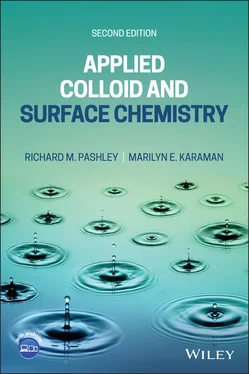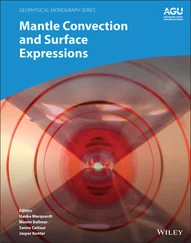1 Cover
2 Title Page
3 Copyright Page
4 Dedication Page
5 Preface
6 About the Companion Website
7 1 Introduction INTRODUCTION TO THE NATURE OF COLLOIDAL SOLUTIONS THE FORCES INVOLVED IN COLLOIDAL STABILITY TYPES OF COLLOIDAL SYSTEMS THE LINK BETWEEN COLLOIDS AND SURFACES WETTING PROPERTIES AND THEIR INDUSTRIAL IMPORTANCE Appendix
8 2 Surface Tension and Wetting THE EQUIVALENCE OF THE FORCE AND ENERGY DESCRIPTION OF SURFACE TENSION AND SURFACE ENERGY DERIVATION OF THE LAPLACE PRESSURE EQUATION METHODS FOR DETERMINING THE SURFACE TENSION OF LIQUIDS CAPILLARY RISE AND A FREE ENERGY ANALYSIS THE KELVIN EQUATION THE SURFACE ENERGY AND COHESION OF SOLIDS THE CONTACT ANGLE SAMPLE PROBLEMS FOR CONSIDERATION/TYPICAL QUESTIONS FOR CONSIDERATION/TYPICAL QUESTIONS
9 3 The Prevention of Fluid Cavitation A SHORT HISTORY OF CAVITATION IN FLUIDS THEORETICAL PREDICTION OF THE LINK BETWEEN DEGASSING AND CAVITATION PRESSURE QUESTIONS
10 4 Thermodynamics of Adsorption BASIC SURFACE THERMODYNAMICS THE GIBBS ADSORPTION ISOTHERM DETERMINATION OF SURFACTANT ADSORPTION DENSITIES SAMPLE PROBLEMS FOR CONSIDERATION/ TYPICAL QUESTIONS
11 5 Surfactants and Self‐Assembly INTRODUCTION TO SURFACTANTS THERMODYNAMICS OF SURFACTANT SELF‐ASSEMBLY SELF‐ASSEMBLED SURFACTANT STRUCTURES SAMPLE PROBLEMS FOR CONSIDERATION/TYPICAL QUESTIONS
12 6 PFAS Contamination BACKGROUND TO PFAS CONTAMINATION SO HOW DO WE REMOVE PFAS COMPOUNDS FROM THE ENVIRONMENT? A SURFACE CHEMISTRY APPROACH
13 7 Emulsions and Microemulsions THE CONDITIONS REQUIRED TO FORM EMULSIONS AND MICROEMULSIONS PHOTOGRAPHIC EMULSIONS EMULSIONS IN FOOD SCIENCE EMULSIONS USED FOR EXPLOSIVES IN MINING OPERATIONS
14 8 Charged Colloids THE FORMATION OF CHARGED COLLOIDS IN WATER THE DEBYE LENGTH THE SURFACE CHARGE DENSITY THE ZETA POTENTIAL THE HUCKEL EQUATION ( κa < 0.1) THE SMOLUCHOWSKI EQUATION ( κa > 100) CORRECTIONS TO THE SMOLUCHOWSKI EQUATION THE ZETA POTENTIAL AND FLOCCULATION THE INTERACTION BETWEEN ELECTRICAL DOUBLE LAYERS THE DERJAGUIN APPROXIMATION SAMPLE PROBLEMS FOR CONSIDERATION/TYPICAL QUESTIONS
15 9 Van Der Waals Forces and Colloid Stability HISTORICAL DEVELOPMENT OF VAN DER WAALS FORCES AND THE LENNARD‐JONES POTENTIAL DISPERSION FORCES RETARDED FORCES VAN DER WAALS FORCES BETWEEN MACROSCOPIC BODIES THEORY OF THE HAMAKER CONSTANT USE OF HAMAKER CONSTANTS THE DLVO THEORY OF COLLOID STABILITY
16 10 Bubble Coalescence, Foams and Thin Surfactant Films THIN‐LIQUID‐FILM STABILITY AND THE EFFECTS OF SURFACTANTS THIN‐FILM ELASTICITY REPULSIVE FORCES IN THIN LIQUID FILMS FROTH FLOTATION THE LANGMUIR TROUGH
17 11 Bubble Column Evaporators THE BUBBLE COLUMN EVAPORATOR PROCESS BUBBLE WATER VAPOUR EQUILIBRATION BUBBLE RISE VELOCITY THERMAL ENERGY BALANCE IN THE BCE FURTHER APPLICATIONS OF THE BUBBLE COLUMN EVAPORATOR (BCE) BCE FOR EVAPORATIVE COOLING SEAWATER DESALINATION USING THE BUBBLE COLUMN EVAPORATOR ENHANCED SUPERSATURATED BUBBLE COLUMN DESALINATION ENHANCED BUBBLE COLUMN DESALINATION USING HELIUM AS A CARRIER GAS WATER STERILIZATION USING BCE THERMOLYSIS OF SOLUTES IN AQUEOUS SOLUTION INHIBITION OF PARTICLE GROWTH IN A BCE SAMPLE QUESTIONS
18 AppendicesAPPENDIX 1 APPENDIX 2 APPENDIX 3
19 Index
20 End User License Agreement
1 Chapter 1 Table 1.1 Table 1.2
2 Chapter 2 Table 2.1
3 Chapter 3Table 3.1 Experimental results of the degassing effects on cavitation observe...
4 Chapter 5Table 5.1
5 Chapter 7Table 7.1
6 Chapter 9Table 9.1Table 9.2Table 9.3Table 9.4 Critical Coagulation Concentrations (in mM).
1 Chapter 1 Figure 1.1 Scanning electron microscope image of dried mono‐disperse silica ... Figure 1.2 Schematic diagram to illustrate the complete bonding of liquid mo... Figure 1.3 Water molecules form hydrogen bonds with the silanol groups at th... Figure 1.4 Water molecules can only weakly interact (by vdw forces) with a m... Figure 1.5 A non‐wetting water droplet on the surface of methylated, hydroph... Figure 1.6 Clean glass flask with water wetting film and start of mist layer...
2 Chapter 2 Figure 2.1 Photograph of a soap bubble. Figure 2.2 Photograph of flat soap film with a variety of drainage thickness... Figure 2.3 Diagram of a soap film stretched on a wire frame. Figure 2.4 Diagram of a spherical air bubble in water. Figure 2.5 Schematic illustration of particles (e.g. boiling chips) used to ... Figure 2.6 Photograph and diagram of a pendant liquid drop in air at the end... Figure 2.7 Example of a theoretical calculation of the shape of a liquid dro... Figure 2.8 Schematic diagram of the rise of a liquid that wets the inside wa... Figure 2.9 Schematic diagram of the shape of the meniscus for complete wetti... Figure 2.10 Schematic diagram of the concentration of fruit juice via water ... Figure 2.11 The calculated Laplace pressure generated across a curved interf... Figure 2.12 Schematic diagram showing that the equilibrium vapour pressure c... Figure 2.13 Capillary condensation of water vapour into a crack. Figure 2.14 Diagram of a sessile droplet. Figure 2.15 Graph of the relative vapour pressure against radius of the corr... Figure 2.16 Diagram of the Wilhelmy plate method for measuring the surface t... Figure 2.17 Ideal experiment designed to measure the work required to create... Figure 2.18 An advancing water droplet on Teflon. Figure 2.19 Diagram of a sessile droplet. Figure 2.20 Diagram of the three‐phase line and its perturbation to determin... Figure 2.21 Balance of surface energies at the TPL gives the Young equation ... Figure 2.22 Typical plot of the measured contact angles of a range of liquid... Figure 2.23 Diagram of a bubble selectively collecting hydrophobic particles...Figure 2.24 Two spherical particles held together by a water meniscus.Figure 2.25 Colloidal particle attached to a solid surface by a water menisc...Figure 2.26 Schematic diagram of a cylindrical rod pulled from a liquid surf...Figure 2.27 Illustration of the force pulling on the rod as a function of he...Figure 2.28 Diagram of the apparatus used to measure the surface tension of ...Figure 2.29 Contact angle made by a sessile droplet.Figure 2.30 Schematic diagram of the contact angle apparatus.Figure 2.31 Methylation of the silica surface.
3 Chapter 3Figure 3.1 This diagram illustrates the theoretical calculation of the energ...Figure 3.2 Experimental data which shows the effect of degassed levels on th...Figure 3.3 Calculated cavitation pressures for water obtained using Equation...Figure 3.4 Effect of degassing on cavitation pressure in water.Figure 3.5 Photograph of a propeller used to study cavitation in the laborat...Figure 3.6 Cavitation occurring in air‐equilibrated water at atmospheric pre...Figure 3.7 Cavitation produced in the left‐hand beaker following pressure re...Figure 3.8 Complete cavitation prevention after gassed water was replaced wi...Figure 3.9 Cavitation occurring in flowing tap water at atmospheric pressure...Figure 3.10 Cavitation was completely prevented in gassed tap water after fl...Figure 3.11 Schematic diagram of stationary or boundary layer formation as a...Figure 3.12 Calculated degassing level produced in a thin (quiescent) film o...Figure 3.13 Proposed cavitation number applied to systems with different deg...Figure 3.14 Photograph of a system used to study membrane degassing effects ...Figure 3.15 Vacuum pump system to study the effects of degassing on cavitati...
4 Chapter 4Figure 4.1 Diagram of the variation in solute concentration at an interface ...Figure 4.2 Diagram to illustrate the change in surface energy caused by the ...Figure 4.3 Typical experimental graph of measured surface energy versus conc...Figure 4.4 Schematic diagram of a pore that can be formed in clay crystal do...Figure 4.5 Surface tension data for aqueous solutions of a surfactant with a...Figure 4.6 Schematic diagram of the decrease in surface tension with concent...
Читать дальше












